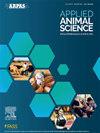Predicting methane emissions from feedlot cattle and application of prediction equations to a synthetic feedlot steer population
IF 1.5
Q3 AGRICULTURE, DAIRY & ANIMAL SCIENCE
引用次数: 0
Abstract
Objective
Our objectives were to develop equations to predict CH4 emissions specific to feedlot cattle and to apply the equations we derived to a synthetic population of feedlot steers created from a commercial database of close-out data.
Materials and Methods
We built a database from the published literature of 98 treatment means from 32 studies that included measures of enteric CH4 emissions and diet composition in cattle fed feedlot-type diets. Enteric CH4 emissions averaged 93.2 g/d, with a mean DMI of 6.6 kg/d, and TDN, NDF, and starch concentrations averaging 82.9%, 20.5%, and 48.5%, respectively. Stepwise regression was used to screen potential dietary variables related to daily CH4 emissions, followed by mixed-model regression to adjust prediction equations for the random effects of study. Close-out data from 3,483 lots of native steers obtained from commercial feedlots in the High Plains region were used to develop a synthetic multivariate normal population of feedlot steers for application of resulting prediction equations.
Results and Discussion
Two regression equations were derived from the database to predict CH4 emissions (g/d): one that included only DMI, and one with DMI and TDN. A third equation that included only TDN was derived to predict CH4 emissions as grams/kilogram of DMI. In addition to regression equations, the use of the database average (adjusted for random effects of study) of 14.11 g of CH4/kg of DMI also was evaluated. Based on resampling analyses of observed versus predicted values, the equation with both DMI and TDN yielded a lower prediction error (24.7 g/d) and greater r2 (0.622) than the DMI-only equation (30.8 g/d and 0.461, respectively). Using the database average of 14.11 g of CH4/kg of DMI gave similar results to the DMI-only regression equation. When applied to the synthetic feedlot steer population, mean, minimum, and maximum daily CH4 emissions were 111.2, 64.7, and 183.3 g/d, respectively, for the DMI plus TDN regression equation.
Implications and Applications
The regression equations we developed, which use commonly available animal and diet information, can be applied to commercial feedlot data to monitor enteric CH4 emissions. As additional CH4 emission data from cattle fed typical feedlot diets become available, our equations can be updated to provide more accurate and precise predictions.
饲养场牛甲烷排放预测及预测方程在综合饲养场牛种群中的应用
我们的目标是建立方程来预测饲养场牛特有的CH4排放,并将我们导出的方程应用于从商业关闭数据数据库创建的饲养场阉牛的合成种群。材料和方法我们从32项研究的98种处理方法的已发表文献中建立了一个数据库,这些研究包括饲喂饲养场型日粮的牛的肠道CH4排放和日粮组成的测量。肠道CH4排放量平均为93.2 g/d,平均DMI为6.6 kg/d, TDN、NDF和淀粉浓度平均分别为82.9%、20.5%和48.5%。采用逐步回归筛选与日CH4排放相关的潜在膳食变量,然后采用混合模型回归调整研究随机效应的预测方程。从高平原地区的商业饲养场获得的3,483批本地阉牛的关闭数据用于开发饲养场阉牛的综合多元正态种群,以应用所得预测方程。结果与讨论从数据库中导出了两个预测CH4排放量(g/d)的回归方程:一个只包含DMI,一个包含DMI和TDN。第三个方程只包括TDN,以克/千克DMI来预测CH4排放量。除回归方程外,还评估了数据库平均值14.11 g CH4/kg DMI的使用情况(根据研究的随机效应进行了调整)。通过对观测值和预测值的重新采样分析,与仅使用DMI的方程(分别为30.8 g/d和0.461)相比,同时使用DMI和TDN的方程的预测误差(24.7 g/d)更低,r2(0.622)更大。使用数据库平均14.11 g CH4/kg DMI得到与仅DMI回归方程相似的结果。DMI + TDN回归方程的CH4日平均排放量为111.2 g/d,最小排放量为64.7 g/d,最大排放量为183.3 g/d。我们开发的回归方程使用常见的动物和饮食信息,可以应用于商业饲养场数据,以监测肠道CH4排放。随着以典型饲养场饲料喂养的牛的更多CH4排放数据的获得,我们的方程可以更新,以提供更准确和精确的预测。
本文章由计算机程序翻译,如有差异,请以英文原文为准。
求助全文
约1分钟内获得全文
求助全文

 求助内容:
求助内容: 应助结果提醒方式:
应助结果提醒方式:


